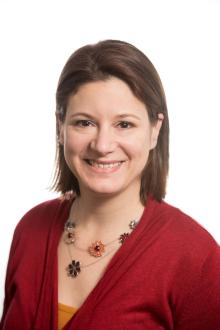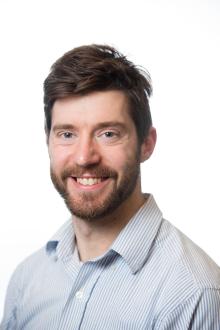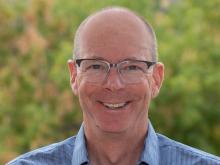PNNL at AGU22
Join us December 12–16 at the American Geophysical Union (AGU) Fall Meeting in Chicago, where the world's top Earth and space scientists will gather

Join PNNL at the American Geophysical Union 2022 Fall Meeting to connect with some of more than 150 researchers whose work will be presented at the event.
(Image by Jeffrey London | Pacific Northwest National Laboratory)
Chicago, IL
The 2022 American Geophysical Union (AGU) Fall Meeting will feature the latest findings of more than 150 researchers from Pacific Northwest National Laboratory (PNNL). Click the navigation links below or scroll this page to learn more about some of the presenters and their science, related announcements and feature stories, opportunities to connect with us at the event, and current job opportunities.
BOOTH INFO | SESSION INFO | ANNOUNCEMENTS | JOB OPPORTUNITIES
Let's Talk!
Stop by our booth (#2100) and learn more about what it's like working for a national laboratory and the exciting scientific breakthroughs happening at PNNL. We’re hiring for a variety of positions and expanding teams to meet new scientific challenges. Meet PNNL engineers, scientists, researchers, managers, and recruiters who can tell you what positions are available and how you can help us change the world!
BOOTH #2100 HOURS:
- Monday, December 12: 3:00 p.m. – 6:00 p.m.
- Tuesday, December 13: 10:00 a.m. – 6:00 p.m.
- Wednesday, December 14: 10:00 a.m. – 6:00 p.m.
- Thursday, December 15: 10:00 a.m. – 1:00 p.m.
Featured PNNL Sessions at AGU
View all PNNL presenters | View all PNNL abstracts
Over 150 PNNL researchers are presenting—in person and virtually—at the largest international Earth science conference. Results from studies across several fields, including atmospheric science, coastal and marine research, Earth modeling, and decarbonization, will be shared. A sample set of these sessions include:
Monday, December 12
Field sampling procedures to quantify riverine plastic pollution in the U.S.

Ruth Branch | Presenter
9:00 a.m. – 9:10 a.m. CST | McCormick Place - E450b (Lakeside, Level 4)
Plastic pollution has been detected in all major U.S. rivers, but not quantified with comparable and consistent methods. The water depth sampled, mesh sizes of nets, sample deployment techniques, and laboratory analysis of samples has varied between rivers, making it difficult to identify the sources and sinks and estimate the amount of plastic being released to the oceans. The U.S. Department of Energy is addressing the problem of riverine plastic pollution with the Waterborne Plastics Resource Assessment and Debris Characterization (WaterPACT) project. One objective of the WaterPACT project is to develop a set of standardized methods to characterize and quantify riverine plastic pollution. Read more.
Multi-sector Dynamics: Energy-Water-Land Interactions at Multiple Scales

Zarrar Khan | Primary Convener
11:00 a.m. – 12:30 p.m. CST | McCormick Place - S504abc (South, Level 5)
The world's energy, water, and land (EWL) systems are in transition and are rapidly integrating, driven by forces such as socioeconomic, climatic, and technological changes, as well as human responses such as the Sustainable Development Goals (SDGs). These dynamics weave across spatial scales, connecting global markets to national, sub-national, and urban economies. At the same time, resources are often locally managed under varying administrative jurisdictions tied to the characteristics of each commodity, such as river-basins for water, grid-regions for electricity, and land-use boundaries for agriculture. Local decisions in turn are critical to the success of national-to-global policies. Read more.
View the poster on this topic Thursday, December 15 from 7:30 a.m. – 10:30 a.m.
The Future Global Water Savings Potential of Agricultural Market Integration

Neal Graham | Presenter
11:24 a.m. – 11:35 a.m. CST | McCormick Place - S504abc (South, Level 5)
Globalization has brought increased access to agricultural trade around the world, which continues to rapidly expand through market integration. This allows regions to meet agricultural demands through a combination of domestic production and trade. These traded goods redistribute water, virtually, around the world. Virtual water trade is an increasingly active area of research, but gaps remain in our understanding of how alternative international trade regimes impact local water resources. Here, for the first time, we explore the impacts of such trade regimes in a fully integrated and water-constrained human-Earth system model on virtual water trade volumes and regional water utilization under reference and future low-carbon transitions. Read more.
Frontiers in Multisector Dynamics: Synergies Across Climate Security, Energy Transitions, and Societal Aspirations

Nathalie Voisin | Convener
4:45 p.m. – 6:15 p.m. CST | McCormick Place - N427A-D
Climate, energy, and society are dynamic, intertwined systems. Projecting the future outcomes and risks of these co-evolving systems is key to ensuring our future climate and energy resilience—but this poses a grand scientific challenge. Tackling this challenge will require the novel integration of data and insights from many divergent fields: known as a multisector dynamics (MSD) perspective. Speakers Sally Benson, Deputy Director for Energy and Chief Strategist for the Energy Transition at the White House Office of Science and Technology Policy; Rob Nicholls, director of the Tyndall Centre for Climate Change Research at the University of East Anglia and lead author of five IPCC reports; Adriano Vinca from the International Institute for Applied Systems Analysis; and Ajay Bhave from the University of Leeds will discuss research strategies and recent scientific advances to address climate security and energy transitions amidst societal changes. Read more.
GC16E - Retrospective Analysis of Drought Impacts on Hydroelectric Power Generation in the Western United States
Vincent Tidwell | Presenter
5:30 p.m. – 5:40 p.m. CST | McCormick Place - S402a (South, Level 4)
The Western United States experiences large fluctuations in rain and snowfall from year to year, affecting river flows and reservoir levels. This interannual variability in water resources leaves a strong signature on total annual energy generated by the region’s fleet of hydroelectric dams. In this retrospective study we analyze the impacts of Western United States droughts on hydroelectric power production by combining two decades’ worth of annual net generation—recorded at more than 600 hydroelectric power plants—with historical climate data developed for key hydropower subregions of the West. Results highlight the role of regional climate diversity in sustaining relatively stable hydropower output during 21st century droughts. Read more.
Tuesday, December 13
Exploring how MultiSector Dynamics Influence the Evolution of the U.S. Electricity System Power Plant Landscape Under a Range of Future Global Climate and Socioeconomic Scenarios
Kendall Mongird | Presenter
3:20 p.m. – 3:31 p.m. CST | McCormick Place - S504abc (South, Level 5)
The locations of future utility-scale electricity generators in the U.S. will be affected by the dynamics and interdependencies between federal and state energy policies, power plant siting regulations, socioeconomics, land use and land cover, climate impacts on renewable resources and electricity demands, and the economics of electricity grid interconnections. Given that the average power plant has a lifetime of 40 years, uncertainties affecting the long-term value of that power create risks for power plant owners and operators. For example, the early retirement of a coal-fired power plant leads to a stranded asset. This presentation will compare renewable and non-renewable power plant siting results in the United States over the 21st century under combinations of shared socioeconomic pathways (SSP3 and SSP5) and representative concentration pathways (RCP8.5 and RCP4.5). Read more.
Cohering insights on coupled human-water interactions across diverse human systems modeling approaches

Jim Yoon | Invited Speaker
4:50 p.m. – 5:00 p.m. CST | McCormick Place - S504abc (South, Level 5)
The role of individual and collective human action is increasingly recognized as a prominent and arguably paramount determinant in shaping the behavior, trajectory, and sustainability of multisector systems. However, the effort to represent human systems in multisector system models has been fragmented across philosophical, methodological, and disciplinary lines. For example, major differences have emerged between modeling communities adopting divergent approaches to representing human systems, ranging from agent-based to computable general equilibrium to system dynamics models, to name only a few. Read more.
Wednesday, December 14
Overview of Urbanization Impact on Regional Climate and Extreme Weather

Yun Qian | Invited Speaker
11:35 a.m. – 11:46 a.m. CST | McCormick Place - S502ab (South, Level 4)
Urban environments lie at the confluence of social, cultural, and economic activities and have unique biophysical characteristics due to continued infrastructure development that generally replaces natural landscapes with built-up structures. The vast majority of studies on urban perturbation of local weather and climate have been centered on the urban heat island (UHI) effect, referring to the higher temperature in cities compared to their natural surroundings. Besides the UHI effect and heat waves, urbanization also impacts atmospheric moisture, wind, boundary layer structure, cloud formation, dispersion of air pollutants, precipitation, and storms. Read more.
Evaluating the water cycle over CONUS at the watershed scale for the Energy Exascale Earth System Model version 1 (E3SMv1) across resolutions

Bryce Harrop | Presenter
12:20 p.m. – 12:30 p.m. CST | McCormick Place - E252 (Lakeside, Level 2)
The water cycle is an important component of the Earth system and it plays a key role in many facets of society, including energy production, agriculture, and human health and safety. Earth system models have been an important tool for deepening our understanding and testing hypotheses related to the water cycle. Continued advances in computing power have enabled earth system models to resolve features important to the water cycle that lower resolution models often fail to capture. In this study, the Energy Exascale Earth System Model (E3SM) is run with low- and high-resolution configurations—as established by the HighResMIP protocol—to evaluate the atmospheric and terrestrial water budgets over the conterminous United States (CONUS) at the watershed scale. Read more.
Thursday, December 15
POSTER: Role of hydropower, wind, and solar in the evolution of global energy under different demand and technological growth scenarios
Thomas Wild | Presenter
9:00 a.m. – 12:30 p.m. CST | McCormick Place - Poster Hall, Hall - A (South, Level 3)
Hydro, wind, and solar power can play a pivotal role in the evolution of global energy to support both energy security and the transition to low-carbon emissions. The extent and rate of expansion of these resources will be driven by several interrelated factors, including demand growth due to socio-economic growth, energy transition to low-carbon with net-zero emission targets, and advancement of evolving supply technologies. We use the Global Change Analysis Model (GCAM) to explore the future global expansion of hydro, wind, and solar power and their anticipated rate of expansion in scenarios with varying demand growth, long-term energy transitions, and technological advancements. Read more.
POSTER: Immediate response of coastal forest soil porewaters to manipulative flooding

Allison Myers-Pigg | Presenter
9:00 a.m. – 12:30 p.m. CST | McCormick Place - Poster Hall, Hall - A (South, Level 3)
Coastal upland forests are facing widespread mortality as sea-level rise accelerates and precipitation and storm regimes change, increasing exposure of coastal upland terrestrial ecosystems to coastal waters. Here we describe the immediate effects of estuarine-water and freshwater inundation on soil porewaters following a manipulative, ecosystem-scale inundation event in a coastal upland forest located at the Smithsonian Environmental Research Center in Maryland, USA. The Terrestrial Ecosystem Manipulation to Probe the Effects of Storm Treatments (TEMPEST) experiment uses a large-unit (2,000 m2) before-after-control-impact experimental design, with three 50-m x 40-m plots serving as control, freshwater, and estuarine-water treatments. Read more.
Impacts of Forest Cover on Hydrologic Extreme Events over the Conterminous United States: Changes and Mechanisms

Zhuoran Duan | Presenter
3:15 p.m. – 3:25 p.m. CST | McCormick Place - E353c (Lakeside, Level 3)
Forest cover can have significant impacts on hydrologic extreme events and therefore hydrologic design through canopy interception and sublimation and changes in snowpack energy balance. In previous work, we developed next-generation Intensity Duration Frequency (NG-IDF) curves for open conditions using the concept of water available for runoff (W), which accounts for the combined effects of rainfall, snowfall, and/or rain-on-snow (ROS) to enhance the hydrologic design. We further developed a suite of enhanced NG-IDF curves for forested land cover conditions using the validated Distributed Hydrology Soil Vegetation Model (DHSVM) at points on a 1/16 degree grid capturing different climate regimes across the conterminous United States (CONUS). By comparing the extreme water available for runoff (W) and the NG-IDF curves of different land cover conditions to their values under open area conditions, we investigated the impacts of forest canopies on both the extreme W and NG-IDF curves for hydrologic design. Read more.
Announcements
Andrew Gettelman Named American Geophysical Union Fellow

Andrew Gettelman, an Earth scientist at Pacific Northwest National Laboratory (PNNL), was named a Fellow of the American Geophysical Union (AGU). Gettelman and 53 others will be honored at AGU’s Fall Meeting 2022. AGU Fellows are recognized for their outstanding achievements and contributions to Earth and space science. The distinction is awarded “of remarkable innovation and/or sustained scientific impact.” Read more.
Explore Career Opportunities at PNNL
Want to join the PNNL team? Check out some of our open positions in:
Earth and Biological
|
Coastal
|
Subsurface |
Earth Systems |